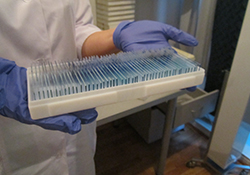Global trends – other microbes

© WHO/Kristin Kremer
Resistance in tuberculosis (TB)
WHO estimates that in 2014 there were about 480 000 new cases of multidrug-resistant tuberculosis (MDR-TB), a form of tuberculosis that is resistant to the 2 most powerful anti-TB drugs. Only about a quarter of these (123 000 cases) were detected and reported. MDR-TB requires treatment courses that are much longer and less effective than those for nonresistant TB. Globally, only half of MDR-TB patients were successfully treated in 2014.
Among new TB cases in 2014, an estimated 3.3% were multidrug-resistant. This figure was 20% among people previously treated for TB.
Extensively drug-resistant tuberculosis (XDR-TB), a form of tuberculosis that is resistant to at least 4 of the core anti-TB drugs, has been identified in 105 countries. An estimated 9.7% of people with MDR-TB have XDR-TB.
Resistance in malaria
As of July 2016, resistance to the first-line treatment for Plasmodium falciparum malaria (artemisinin-based combination therapies, also known as ACTs) had been confirmed in 5 countries of the Greater Mekong Subregion (Cambodia, the Lao People’s Democratic Republic, Myanmar, Thailand and Viet Nam). In most places, patients with artemisinin-resistant infections recover fully after treatment, provided that they are treated with an ACT containing an effective partner drug.
However, along the Cambodia–Thailand border, P. falciparum has become resistant to almost all available antimalarial medicines, making treatment more challenging and necessitating close monitoring. There is a real risk that multidrug resistance will soon emerge in other parts of the Subregion as well. The spread of resistant strains to other parts of the world could pose a major public health challenge and jeopardize important recent gains in malaria control.
The WHO Strategy for Malaria Elimination in the Greater Mekong Subregion (2015–2030) was endorsed by all 5 countries, as well as China.
Resistance in HIV
In 2010, an estimated 7% of people starting antiretroviral therapy (ART) in developing countries had drug-resistant HIV. In developed countries, the same figure was 10–20%. Some countries have recently reported levels at or above 15% among those starting HIV treatment, and up to 40% among people restarting treatment. This requires urgent attention.
Increasing levels of resistance have important economic implications: second- and third-line regimens are 3 times and 18 times more expensive, respectively, than first-line drugs.
Since September 2015, WHO has recommended that everyone living with HIV start on ART. Greater use of ART is expected to further increase ART resistance in all regions of the world. To maximize the long-term effectiveness of first-line ART regimens, and to ensure that people are taking the most effective regimen, it is essential to continue monitoring resistance and to minimize its further emergence and spread. In consultation with countries, partners and stakeholders, WHO is currently developing a new Global action plan on HIV drug resistance (2017–2021).
Resistance in influenza
Antiviral drugs are important for the treatment of epidemic and pandemic influenza. So far, virtually all influenza A viruses circulating in humans are resistant to 1 category of antiviral drugs – M2 inhibitors (amantadine and rimantadine). However, the frequency of resistance to the neuraminidase inhibitor oseltamivir remains low (1–2%). Antiviral susceptibility is constantly monitored through the WHO Global Influenza Surveillance and Response System.



